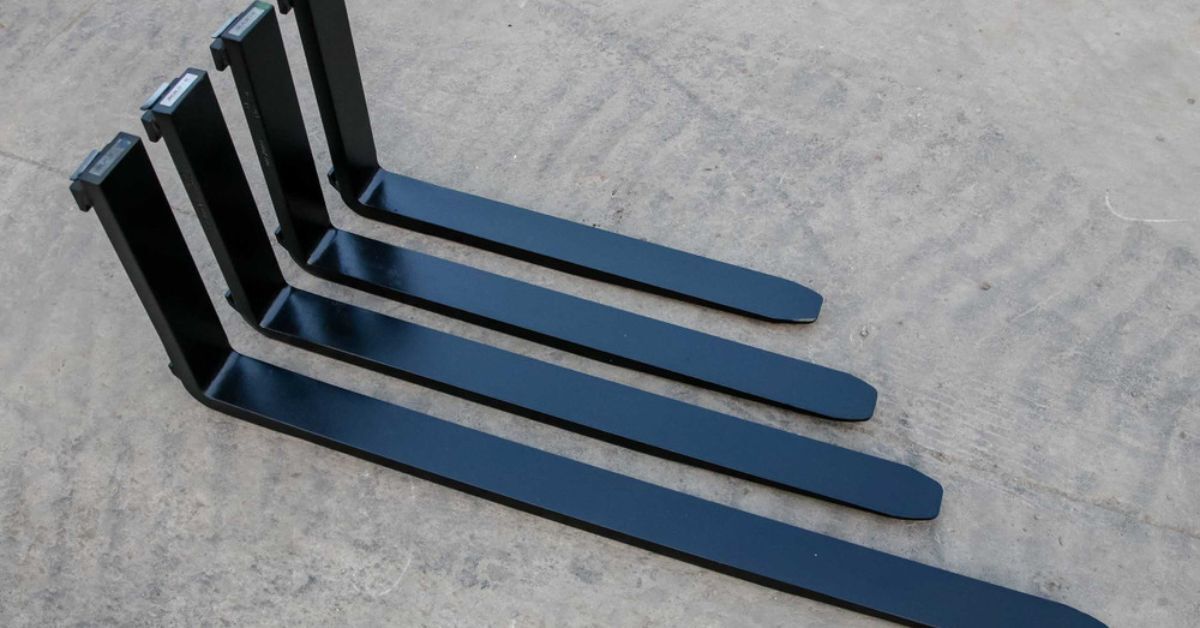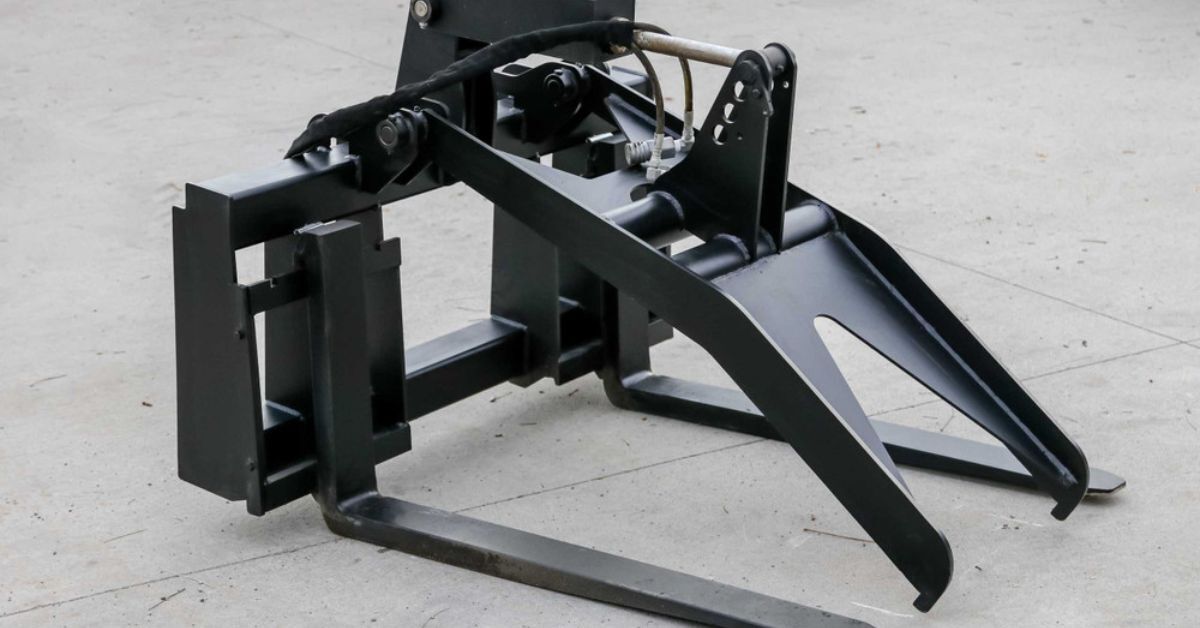Posted by Express Steel on Nov 12th 2025
Choosing Quick-Attach Pallet Forks for Your Fleet
Fleet managers and equipment operators know that versatility drives profitability. When your skid steers can handle multiple tasks efficiently, you maximize equipment utilization while minimizing operational costs. Quick-attach pallet forks represent one of the most valuable investments you can make for your fleet. These attachments transform standard skid steers into material handling powerhouses capable of tackling warehouse, construction, and agricultural applications with precision.
Choosing quick-attach pallet forks for your fleet requires careful consideration of load capacity, construction quality, and operational requirements. The wrong choice can lead to equipment damage, safety hazards, and costly downtime. However, the right selection enhances productivity, reduces labor costs, and extends the versatility of your existing equipment.
This comprehensive analysis examines the critical factors that determine pallet fork performance and longevity. You'll discover how to evaluate specifications, understand construction differences, and match fork capabilities to your specific operational needs.
Understanding Quick-Attach Pallet Forks
Quick-attach pallet forks consist of steel tines mounted on a universal skid steer attachment plate. These attachments connect to your skid steer's quick-attach system, enabling simple installation and removal without additional tools. The design allows operators to switch between pallet handling and other attachments within minutes, maximizing equipment versatility.
Additionally, most quick-attach systems feature hydraulic or mechanical locking mechanisms that secure attachments to the skid steer loader. This connection method ensures safe operation while maintaining the flexibility to change attachments based on task requirements.
Consider Pallet Fork Load Capacities
The load capacity defines the maximum weight your pallet forks can safely manage. Manufacturers determine this capacity based on a standard load center distance—typically 24 inches from the fork face. As the load is positioned further from the quick-attach point, the effective capacity decreases significantly due to leverage principles.
When selecting quick-attach pallet forks, always consider this in conjunction with your skid steer's rated operating capacity. Your total lifting capability is limited by the lower of these two ratings. Your pallet fork selection should adhere to the manufacturer's specified load capacity for both your quick-attach forks and your skid steer. Exceeding these established limits can result in equipment damage, attachment failure, and dangerous tipping conditions, jeopardizing jobsite safety and operational efficiency. Always prioritize safety and performance by considering these critical load limits.

Fork Construction Material Matters
High-strength steel construction ensures durability under demanding conditions. Look for forks manufactured from materials meeting or exceeding industry standards for yield strength and impact resistance. Quality manufacturers use properly heat-treated steel that maintains structural integrity under repeated loading cycles.
Welded joints require particular attention. Full-penetration welds and reinforcement gussets indicate superior construction practices that extend attachment life. Avoid forks with visible weld defects, incomplete penetration, or inadequate reinforcement at stress concentration points.
Determine Your Fork Length Needs
Fork length directly impacts lifting capacity and operational flexibility. Standard lengths range from 36 to 60 inches, with longer options available for specialized applications. Shorter forks provide better visibility and maneuverability in tight spaces, while longer forks accommodate oversized pallets and loads.
Consider your typical pallet sizes and load configurations when selecting length. Standard North American pallets measure 48 inches and can be safely handled by 42 or 48-inch forks. European pallets require attachments that can accommodate their 47.2-inch length pallets.
Evaluate Fork Width and Thickness
Fork width affects load distribution and pallet compatibility. Standard widths range from 4 to 6 inches, with 5-inch forks providing optimal balance between strength and pallet entry capability. Wider forks distribute loads more effectively but may not fit all pallet openings.
Fork thickness influences both strength and weight. Thicker forks handle heavier loads but add weight to your skid steer, potentially reducing overall lifting capacity. Match thickness to your typical load requirements while considering the impact on your machine's performance.
Factor in Fork Positioning and Adjustability
Adjustable fork positioning accommodates various load widths without requiring attachment changes. Side-shift capabilities allow precise load placement, while fork spread adjustment handles different pallet configurations. These features significantly enhance operational efficiency when dealing with diverse load types.
Fixed-position forks cost less initially but limit operational flexibility. Evaluate your typical load variety to determine whether adjustable positioning justifies the additional investment. High-volume operations with consistent load types may benefit from fixed configurations.

Determine Which Quick-Attach System Works Best
Universal quick-attach systems provide compatibility across multiple skid steer brands. However, manufacturer-specific systems may offer enhanced features or improved security. Verify compatibility with your existing fleet before making attachment purchases.
Consider future equipment acquisitions when selecting attachment systems. Standardizing on one quick-attach type simplifies inventory management and allows for attachment interchangeability across your fleet.
Evaluate Manufacturer Quality
Research manufacturer reputation, warranty terms, and service support availability. Established manufacturers with comprehensive warranty coverage demonstrate confidence in their products. Local service availability reduces downtime when repairs become necessary.
Request references from similar operations and investigate actual performance records. Quality manufacturers readily provide customer references and performance documentation. Avoid suppliers unwilling to support their claims with verifiable evidence.
Prioritize Safety Features
Safety features should protect operators and equipment while meeting regulatory compliance standards. Important features include proper load ratings, clear capacity markings, and adequate visibility around the attachment. Some forks include optional safety accessories such as load guards or operator warnings.
Hydraulic cylinders and hoses require protection from damage during operation. Look for forks with integrated guards or routing systems that prevent hydraulic line damage. Regular inspections and maintenance of hydraulic components leads to safe operations.
Consider Your Operating Conditions
Environmental conditions significantly impact attachment longevity and performance. Corrosive environments require special coatings or materials to prevent premature failure. Temperature extremes affect hydraulic performance and material properties.
Indoor warehouse operations typically involve clean, controlled conditions that extend attachment life. Outdoor construction or agricultural applications expose forks to moisture, chemicals, and abrasive materials requiring more robust construction materials.
Review Maintenance Requirements
Regular maintenance extends attachment life and ensures safe operation. Typical requirements include periodic lubrication, hydraulic system inspection, and structural examination for wear or damage. Quality forks for skid steer applications require minimal maintenance when operated within specifications.
Document maintenance activities to track attachment performance and identify any potential issues. Preventive maintenance costs significantly less than emergency repairs or equipment replacement.
Explore Specialized Fork Options
Specialized applications may require custom fork configurations or additional features. For instance, extended-length forks handle oversized loads, while reduced-capacity forks work effectively on smaller skid steers. Evaluate specialized options based on frequency of use and operational benefits. Custom attachments cost more but provide significant advantages when properly matched to specific applications.
Making Your Fleet Investment Decision
Choosing quick-attach pallet forks for your fleet requires balancing initial costs against long-term operational benefits. Quality attachments provide years of reliable service while enhancing equipment versatility and operator productivity. Start by evaluating your current and anticipated operational requirements. Match fork specifications to your heaviest and most demanding applications while ensuring compatibility with your existing equipment.
Ready to enhance your fleet's capabilities? Express Steel offers a variety of American-made quick-attach pallet forks for skid steer operations. Browse our selection today to find the attachments you need to make your next pallet management project a breeze.


